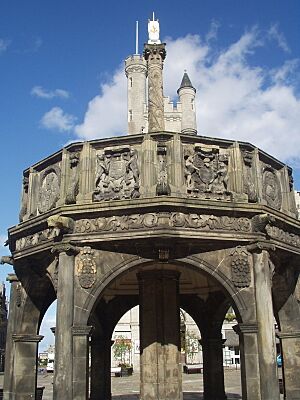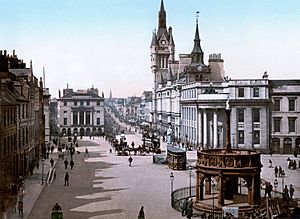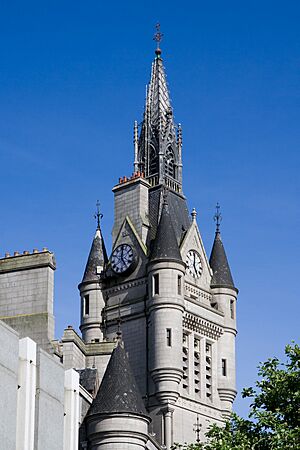History of Aberdeen facts for kids
People have lived in the area of Aberdeen since the Stone Age. The city of Aberdeen grew from two separate towns: Old Aberdeen and New Aberdeen. Old Aberdeen was a place for the university and a big church, located near the River Don. New Aberdeen was a busy fishing and trading town, built where the Denburn stream met the River Dee.
Contents
Early History of Aberdeen
First Settlers and Ancient Times
Around 6000 BC, the first people, who were hunter-gatherers, settled near the mouths of the River Dee and River Don. Later, around 2000 BC, the Beaker People arrived from lands near the Rhine river. They built the mysterious stone circles you can still find in the Aberdeenshire area.
Around 400 BC, Celtic groups from northern Scotland moved into the area.
Romans and Christianity
The Romans came to Aberdeenshire in the first century AD. Agricola, a Roman leader, led about 40,000 soldiers into Caledonia (which is now Scotland) in 84 AD. They fought and defeated the united armies of the Picts in the Battle of Mons Graupius. This battle happened near the peak of Bennachie in Aberdeenshire.
After the Romans left, the local people of Aberdeenshire started to become Christian. Old Aberdeen's first church was built around 580 AD. St Kentigern sent St Machar to teach the Picts about Christianity. Today, St Machar's Cathedral is named after him and became the main church for the bishop of Aberdeen.
Aberdeen's Growth: 1136 to the 1700s
Royal Charters and Independence
In 1136, King David I started to develop New Aberdeen. Aberdeen's oldest surviving official document, called a charter, was given by King William the Lion around 1179. This charter confirmed the trading rights for the town's citizens. The city received other important royal charters later, especially the Great Charter of 1319.
After William Wallace was executed in 1305, parts of his body were sent to different places to warn others. One part was buried in the walls of St Machar's Cathedral in Aberdeen.
In 1319, the Great Charter from Robert the Bruce made Aberdeen a property-owning and financially independent community. Bruce respected the people of Aberdeen because they had helped him when he was an outlaw. They also helped him win the Battle of Barra and defeat the English soldiers at Aberdeen Castle. He gave Aberdeen the nearby Forest of Stocket. The money earned from this land still helps the city's Common Good Fund, which benefits all people in Aberdeen today.
Medieval Records and Fortifications
Aberdeen's old council records, called "common books," have survived from 1398 onwards. These records are special because there are so many of them and they cover such a long time. The first eight books, from 1398 to 1511, are so important that they are listed in the UNESCO UK Memory of the World Register.
In 1336, Edward III of England burned Old Aberdeen, but the city was quickly rebuilt and made bigger. For many centuries, the city faced attacks from nearby lords. It was strongly fortified with walls and gates, but all the gates were removed by 1770. Royal charters in 1489 and 1498 created a free town to be managed by the church. In 1497, a strong building called a blockhouse was built at the harbour entrance to protect against the English.
During the Wars of the Three Kingdoms (1644-1647), the city was attacked by both sides. In 1644, Royalist troops, including Irishmen and Highlanders, took over and looted the city after the Battle of Aberdeen.
In 1647, a terrible disease called bubonic plague broke out. About a quarter of Aberdeen's population died. Later, in 1715, the Earl Marischal announced the Old Pretender as king in Aberdeen. In 1745, Duke of Cumberland stayed in the city for a short time before attacking the Young Pretender.
Aberdeen in the 18th and 19th Centuries
New Services and City Planning
The 18th century brought the start of social services to Aberdeen. The Infirmary (a hospital) opened in 1742 at Woolmanhill, and a hospital for mental health opened in 1779.
In the late 1700s, the city council started a big project to improve roads. By 1805, George Street, King Street, and Union Street were open. Building Union Street was an amazing engineering feat. It involved flattening parts of St Catherine's Hill and building arches to carry the street over Putachieside. The street crossed the Denburn Valley with a single arch that was 130 feet (40 meters) wide. Along these new streets, the core of the Granite City was built. Many of its buildings were designed by famous architects like John Smith and Archibald Simpson.
Harbour and Infrastructure Improvements
The 19th century was a time of great expansion for Aberdeen. The city's growing importance in trade, shipbuilding, and fishing meant that better harbour facilities were needed. Much of the harbour you see today was built during this century. This included Thomas Telford's extension to the North Pier (1810–1815), the Victoria Dock (finished 1848), and the South Breakwater.
Such expensive building projects caused problems, and in 1817, the city went bankrupt. However, Aberdeen recovered thanks to the general prosperity that followed the Napoleonic wars. Street lighting improved in 1824 with the arrival of gas. The water supply got much better in 1830 when water was pumped from the Dee river to a reservoir in Union Place. An underground sewage system began in 1865, replacing the open sewers that used to run along some streets.
Transport and Local Government
Aberdeen was the main office for the Great North of Scotland Railway, which started in 1846. The city also had Aberdeen Corporation Tramways, which provided public transport until they closed in 1958.
The Aberdeen United Trades Council was formed in 1868. It quickly became important in the city, supporting candidates for the council and campaigning for shorter working hours.
Aberdeen Town House was finished in 1874. The city officially became an incorporated city in 1891. In 1899, Aberdeen was separated from the county of Aberdeenshire for administrative reasons, becoming a "county of a city."
Aberdeen in the 20th Century
By 1921, Aberdeen's population had grown to 158,969 people.
George VI visited Aberdeen in 1925 to open the Memorial Court, which is part of the Aberdeen Art Gallery.
During World War II in 1943, the German air force (Luftwaffe) dropped 129 bombs on Aberdeen. This event, known as the Aberdeen Blitz, caused 125 deaths and significant damage to the city.
In 1964, there was a food poisoning outbreak in Aberdeen. This was caused by contaminated meat sold from a shop on Union Street. The illness was typhoid. After the outbreak, the food shop closed.
In 1930, Aberdeen's status as a "county of a city" was confirmed by a new law. However, in 1975, counties of cities were abolished. The area of the former city was then combined with nearby rural areas to form a new district in the Grampian Region. When districts and regions were abolished in 1996, this district became a single council area known as Aberdeen City.
Today, even though Old Aberdeen still has its own history, it and New Aberdeen are no longer truly separate. The city now includes the former towns of Old Aberdeen, New Aberdeen, Woodside, and the Royal Burgh of Torry (south of the Dee river).
See also
- Aberdeen typhoid outbreak 1964
- Etymology of Aberdeen
- History of Aberdeen F.C.




